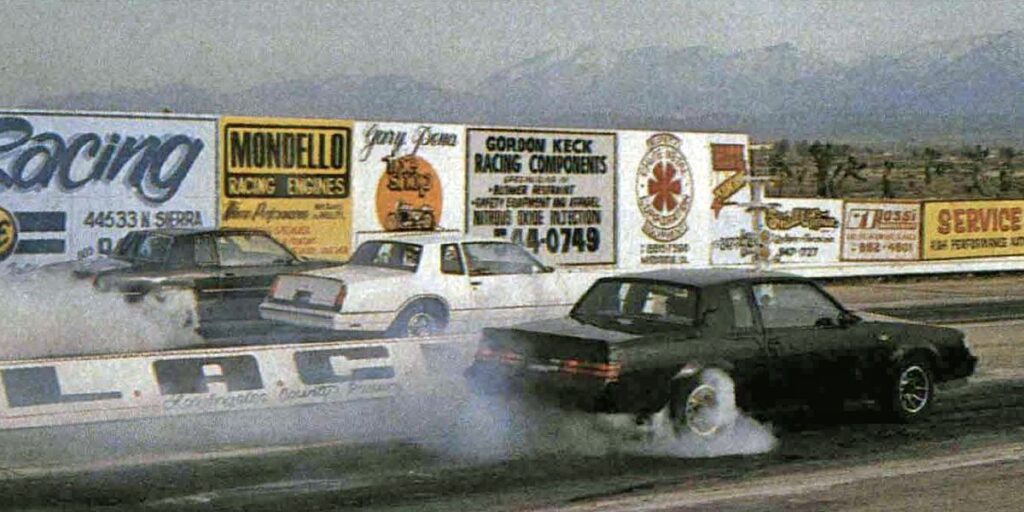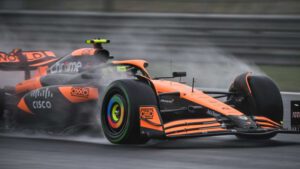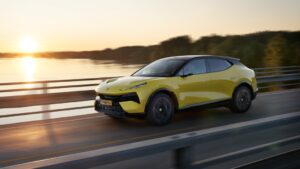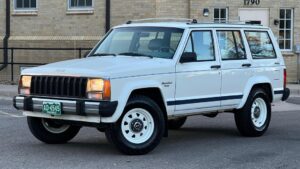1980s Muscle Car Comparo: Buick Regal Grand National, Chevy Monte Carlo SS, Olds 442

From the July 1985 issue of Car and Driver.
One cannot take life too seriously when one looks at it from inside a Monte Carlo SS, a Buick Regal Grand National, or—to a lesser degree—an Olds 442. These cars are for taking large numbers of friends and great quantities of beer to the beach. Nobody worries about Central America or school prayer when sashaying down the highway in a car that’s the rolling embodiment of everything the Beach Boys sang about in the Sixties.
Television and the weekly news magazines would have us believe that every young person in America was out on the barricades in the Sixties and early Seventies, tossing tear-gas canisters back at the cops and praying the old VW bus could make it over the border to Canada. The truth is that the vast majority of kids never even saw a barricade or got a whiff of tear gas. Hordes of America’s flaming youth drank beer, raised hell, tore around in cars not unlike the three we have here today, and waited to see if they were going to get called up for Vietnam.
Nostalgia is what these three vehicles are all about. When you’ve been driving any one of the three for more than about five minutes, you begin to wish that you’d brought along all of your Frankie Valli/Del Shannon/Jan and Dean/Lovin’ Spoonful cassettes—not to mention everything ever produced by Phil Spector or recorded by the aforementioned Beach Boys. With “My Little Runaway” blasting out of the speakers, you’re not really concerned with the fact that these cars have been left in the dust by modern automotive technology. You don’t even mind too much when some adolescent in an Omni GLH Turbo does the same thing.
We’ve long admired the appearance of the Buick Grand National and the Chevrolet Monte Carlo SS, and we were finally moved to bring GM’s three more-or-less muscle cars together for a test by the rather pleasant weeks we’d spent driving an Olds 442 through the snowdrifts and slop of a nasty Michigan winter. It’s possible—to some degree—to forecast the good, the bad, and the ugly high-speed dynamic characteristics of a car based on its behavior at lower speeds on snow and ice, and the 442 behaved admirably when tossed around on the local low-coefficient surfaces. Thus, when the weather began to clear and spring made an appearance, we lined up all three for a nostalgic romp through what’s left of Muscle Car Land.
The Buick is by far the meanest-looking. It is also the fastest, because it carries marginally less weight, and because its turbocharged V-6 engine puts out 20 more horsepower than either the Olds or the Chevy (200 to their 180). The Buick definitely makes the greatest impression on the mob. It really carries the same feeling of menace as an attack helicopter, and its exhaust note has a lovely, moaning rap that’s guaranteed to raise a young male’s pulse rate by about fifteen points.
The Chevy looks more like a NASCAR stocker, and of course, that was the idea. As clunky as a standard Monte Carlo looks, it is nonetheless one of NASCAR’s most successful racing shapes, and Chevrolet’s stylists didn’t have to do much to capture the character of the race cars in the SS. Everything about the Chevy is skewed toward that perception except the interior. The paint-and-decal scheme, the wheels and tires, the suspension settings, the front and rear aero aids, and a burbling V-8 noise all combine to enhance the Darlington 500 effect.
The Olds doesn’t seem to have its heart in this competition. Aside from its wheels and tires and a handful of 442 decals, it could be any other Cutlass two-door sedan. Similarly, the interior is all Cutlass, so the car turns out to be less a theme car or character car than a regular Cutlass with some worthwhile performance options. In fact, we’d be delighted to see all of the old front-engine, rear-drive Cutlasses come out of the factory equipped like our 442. . . Then the Oldsmobile Division could devote itself to creating a 442 performance-and-personality package that would really make a statement.
The Chevrolet, the Buick, and the Olds all share a common body shell, as well as an automatic transmission, front and rear suspensions, brakes, tires, and front-seat frames. Each division was able to fiddle with spring and shock-absorber rates, antiroll bars, bushings, and steering ratios, and to install its own engine and torque-converter calibrations. (None of the three offers a manual gearbox, worse luck.) When you drive all three back to back, the degree to which their respective divisions have been able to make them different from one another is surprising. All three driving seats feel the same, which is to say substandard, and all control relationships are more or less identical, but after that, the three cars begin to separate.
As we’ve said, the Oldsmobile is the least imposing of the three. It is powered by a five-liter version of the old Olds 350 V-8, and the emphasis is on low- and midrange torque. The cast-iron engine is dressed with the same Rochester four-barrel carburetor that’s on the Chevy, and the power flows through the same four-speed automatic transmission, but there the resemblance ends. The factory specifies tire pressures of 35 psi all around, and this made the 442 a little harsh and thumpy. Yet the overall feeling in the 442 was one of softness and undamped wheel movements. We were thus a little surprised to find that the Olds was quite happy when driven fast on our test roads—Southern California’s Mulholland Drive and Angeles Crest Highway—even when the pavement was rough and the shoulders were crumbled. Much like the true muscle cars of days gone by, with their flabby suspension and vague steering, one simply tossed the 442 into the corner, allowed the suspension to compress all the way, and then rode it around on the rubber bump stops. Worked fine, despite all kinds of early warnings of imminent disaster.
The Buick was another matter altogether. The Buick, on the strength of its exterior appearance and its wonderful V-6 engine, promised everything but was really unhappy when the road got rough and twisty at the same time. The shock absorbers just seemed to give up. And since the engine’s performance was so far superior to that of the other two, it only took a small squirt of throttle to get oneself well and truly launched into the next corner. After about three such corners, filled with sturm und drang and flying elbows, we learned to modulate the pressure on the loud pedal.
Buick’s 3.8-liter turbo V-6 is a great engine in search of a great car. Its performance is so good that it cries out for a more stable platform than the one offered by the Grand National. Let our technical editor describe it in greater detail:
“Although it has only three-quarters the displacement and uses the same pushrod valve gear of its competitors’ V-8 engines, the Buick motor easily outmuscles them both. The source of its power is a computer-controlled AiResearch T3 turbocharger, which is allowed to generate up to 15 psi of boost under favorable conditions. The proper fuel quantity to match the blown engine’s deep breathing is determined by the same computer, using a mass-airflow sensor and various temperature and pressure sensors. Each cylinder’s dose of fuel is then metered very accurately by sequentially firing electronic injectors. The computer also determines the optimal spark timing and ignites each cylinder’s charge with a high-precision, distributor-less ignition system. The result of this exotic technology is a nice, round 200 horsepower and 300 pound-feet of torque.”
The Monte Carlo’s L69 engine is an American classic: a 305-cubic-inch version of the 30-year-old Chevy small-block V-8. Think of it as either the carbureted Z28 engine or a regular old Chevy V-8 with a 9.5 compression ratio and a Corvette camshaft. Either way, it delivers a very pleasing 180 horsepower. Not as spectacular as the Buick’s turbo V-6, but more than ample for styling and profiling, it moves the Monte Carlo along at a pace that would have been unimaginable five years ago.
These cars are true enthusiasts’ vehicles, in that they really don’t make a lot of sense. They’re performance cars that don’t really go all that fast; flash cars with the look and the smell and the roar of race cars, but the soul of mom-and-pop sedans. But it’s astonishing how much fun they are. And that’s the whole point. People stare at them. They look terrific. The Buick is about perfect as automotive graphics go, but the Olds and the Monte Carlo have their own songs to sing.
Every one of the three deserves a better interior. The seats just don’t get it, but our guess is that the target customers for the Olds and the Chevy don’t worry too much about seats and ergonomics—that’s for Porsche people and other poseurs. The Buick, though, is different. First of all, it’s a bit more expensive, and it’s so black, so sleek, that one really ought to be able to yank the door open and be stunned by a gorgeous high-tech interior, including an up-to-date package of analog instruments.
The Monte Carlo SS was our overall favorite, with the Buick a very close second. The Monte Carlo doesn’t go as fast or look as mean as the Buick Grand National, but the Monte Carlo offers its driver a nicely balanced portfolio of acceleration, braking and handling, and NASCAR style. It’s clear that Chevrolet gave this car a great deal of thought, because it delivers. The decals and special trim mask no disappointments. The car is what it says it is, and does what it looks like it ought to do. It rolls along the freeway just like a grown-up automobile, yet handles the swoops and humps of the Angeles Crest and Mulholland Drive like a great big sporty car. It ought to be sensational for delivering the beer and friends to the beach for this weekend’s volleyball tournament.
Arrow pointing downArrow pointing down
Specifications
Specifications
1985 Buick Regal Grand National
200-hp turbocharged V-6, 4-speed automatic, 3460 lb
Base/as-tested price: $13,565/$16,289
C/D TEST RESULTS
60 mph: 7.5 sec
1/4 mile: 15.7 sec @ 87 mph
100 mph: 22.9 sec
Braking, 70–0 mph: 198 ft
Roadholding, 300-ft-dia skidpad: 0.80 g
C/D observed fuel economy: 17 mpg
1985 Chevrolet Monte Carlo SS
180-hp V-8, 4-speed automatic, 3530 lb
Base/as-tested price: $11,608/$14,430
C/D TEST RESULTS
60 mph: 7.8 sec
1/4 mile: 15.9 sec @ 86 mph
100 mph: 25.6 sec
Braking, 70–0 mph: 204 ft
Roadholding, 300-ft-dia skidpad: 0.80 g
C/D observed fuel economy: 18 mpg
1985 Oldsmobile 442
180-hp V-8, 4-speed automatic, 3570 lb
Base/as-tested price: $11,745/$14,366
C/D TEST RESULTS
60 mph: 9.1 sec
1/4 mile: 16.6 sec @ 83 mph
100 mph: 31.3 sec
Braking, 70–0 mph: 204 ft
Roadholding, 300-ft-dia skidpad: 0.78 g
C/D observed fuel economy: 14 mpg




